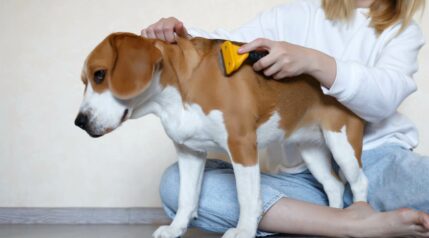One of the most common concerns pet parents have is their dog becoming upset or destructive when they are left alone. We hate to think of our pets feeling unhappy, and dealing with separation anxiety can be challenging.
Anxiety can have a multitude of causes and symptoms but is typically associated with a dog being fearful or anxious about being separated from its owner. So how do you know if your pet is suffering when left alone?
Some research has shown that around half of dogs who suffer from separation anxiety don’t show any signs at all. That’s why we’ve put together this helpful guide to help you understand how your dog might feel when they are alone and how you can help them to feel safe and relaxed when you leave the house.
What Is Separation Anxiety?
Separation anxiety is a collection of behaviors that occur when a dog finds it stressful being apart from its owners. It can develop for several reasons, but usually, it happens when a dog has never learned to be alone.
When puppies are separated from their mother and littermates, they will usually whine or bark and try to get back to them. They then become emotionally attached and bonded to their new human family.
It’s important that dogs can be left for short periods of time, either alone or with other people, and they need to feel confident and relaxed doing so. But many dogs, for a range of reasons, are never separated from their owner and cannot cope when they are.
What Causes Separation Anxiety?
There is no evidence to demonstrate exactly why some dogs develop anxiety when separated from their humans, but there are a few things we know can trigger it.
- Change in owner – a new family, such as in cases where dogs have been rehomed, can be an important trigger
- Change in routine – dogs are creatures of habit and sensitive to changes such as who is at home with them during the day, when they are fed and walked, and how long they spend alone
- Moving houses – a new environment can make your dog feel anxious and trigger it if they feel insecure while settling into their new home
- New people in the house – a new baby, a new family member moving in, or the loss of a family member can cause anxiety
- Boredom and frustration – dogs need plenty of stimulation to keep their body and minds healthy, and if your dog doesn’t get enough exercise or playtime, that leftover energy can manifest as anxiety or attention-seeking behaviors
- Fear – this is common in rescue dogs who have suffered abuse or neglect or dogs who haven’t developed confidence in a variety of settings. Fear can develop into anxiety, and dogs might seek comfort and support from their owner, leading them to struggle with being apart
Symptoms Of Separation Anxiety

Anxiety can manifest differently in every dog, and while some display obvious symptoms, other dogs might be suffering in silence while you are out and behaving normally when you return home.
Some of the most common symptoms are:
- Pacing
- Trembling
- Excessive panting or yawning
- Drooling
- Whining, barking, or howling
- Destructive behaviors
- Urinating or defecating in the house
- Ears back and tail between the legs
Of course, it’s important to remember that some of these symptoms could also indicate that your dog has a medical problem, and it’s important to get your pet checked at the vet to rule these out before starting any training.
What If It’s Not Separation Anxiety?
Around 8 in 10 dogs struggle to be apart from their humans. However, some of the symptoms of anxiety from separation could also indicate that your pet has a medical problem. It’s important to rule out other causes before continuing with treatment and training, and you should always get your dog checked at the vet first.
What Should I Do If My Dog Has Separation Anxiety?
Once you have recognized that your dog is showing signs of sadness when separated, speak to your vet and discuss a referral to a qualified behaviorist. It’s also important that your vet can rule out any other medical causes for your dog’s behavior. You should never punish your dog for their behavior, as they don’t understand that it’s wrong and are only doing it because they feel stressed.
Next, you need to try and identify the cause and triggers, as this will help guide the treatment plan. It can be very tricky to find the cause, and often there are multiple factors, of course, you are out of the house when your dog is most anxious! Some worried pet parents can set up a camera in the house to see exactly what their dog is doing when they leave the house – this can be useful to identify any environmental triggers such as loud noises or other dogs barking. A behaviorist can also come into your home and help you work out exactly what’s going on with your individual dog.
The aim of treating a dog with anxiety is to teach them to relax and enjoy being left alone, to tolerate it, and to know that nothing bad is going to happen. Often the situation cannot be completely resolved, and it takes time and patience to support your dog through treatment. Encouraging your dog to relax at home and not rely on your company is key.
How Is Separation Anxiety Treated?

The treatment for detachment anxiety depends on the individual dog, its symptoms, and the cause. Your vet or a registered behaviorist can help you identify this, and working through a treatment plan with them is often the best way to help your dog.
Here are some of the most common treatment methods for treating:
- Make sure you have a consistent routine – dogs are creatures of habit, and having a regular routine for exercise, feeding, and your own habits can help them feel confident and secure
- Ensure you give your dog enough exercise and feed them a suitable diet
- Start spending more time apart – leaving your dog alone should be part of your routine
- Minimize any disturbances such as noise by leaving a radio or television on, closing the curtains, and leaving your dog in a quiet part of the house.
- Play classical music – this is known to have a calming effect!
- Make sure your dog has plenty of toys. Lick mats, puzzles, and other brain games can provide distraction and occupy your dog’s mind while you’re out
- Get a regular dog sitter – getting to know a good dog sitter and them getting to know your dog is really important, as you will have peace of mind when you go out that your dog is not alone, and gets your pup used to spending time with other people. We recommend using Rover to find your sitter
- Make sure your dog has had a walk and eaten a meal before you go out to avoid boredom and frustration
Important things to remember when training your dog to be left alone:
- Establish how long your dog is happy to be left alone by leaving the room, and note how long before your dog starts to appear distressed
- Work slowly and within your dog’s limits, and never punish them for their behavior
- Use plenty of high-quality rewards and verbal praise to reinforce good behavior
- Gradually build up the time you leave your dog alone
For severe cases, there are medications that vets can prescribe to treat anxiety. They can be helpful for some dogs but should be reserved for very serious anxiety and only treat the symptoms, not the underlying cause. CBD may also prove helpful for managing stress, but it is wise to check with your vet before starting your pet on any new supplements or medications.
How Can I Prevent Separation Anxiety?

Building up your dog’s confidence and encouraging their independence from a young age is crucial to helping your dog when it comes to spending time on their own. Your dog needs to know that it is okay to be alone sometimes. But this doesn’t mean going out and leaving them all the time to get them used to it. You need to build this up over time.
You should start getting your dog used to being alone from a young age by going to a different part of the house for 10 minutes at a time. You can slowly build this up to 20 or 30 minutes and start leaving the house. Building it up slowly will mean that you can soon start to pop out for an hour. Make sure that when you do this, your dog is in a crate or safe space with plenty of toys and distractions and has been fed and walked.
How Long Can I Leave My Dog Alone?
Dogs should not be left alone for more than 5 to 6 hours at the absolute most, and 4 hours is usually long enough for most dogs. If you need to go out for longer, see if you can take your dog with you or arrange for a friend or dog sitter to go into your home.
Final Thoughts
Remember that you should always speak to your vet for advice first and seek help from a qualified behaviorist if you are worried about your pet. Spotting the signs, getting your pet used to being alone, and working on training techniques will all help on the journey to your dog feeling safe and relaxed without you by their side.




